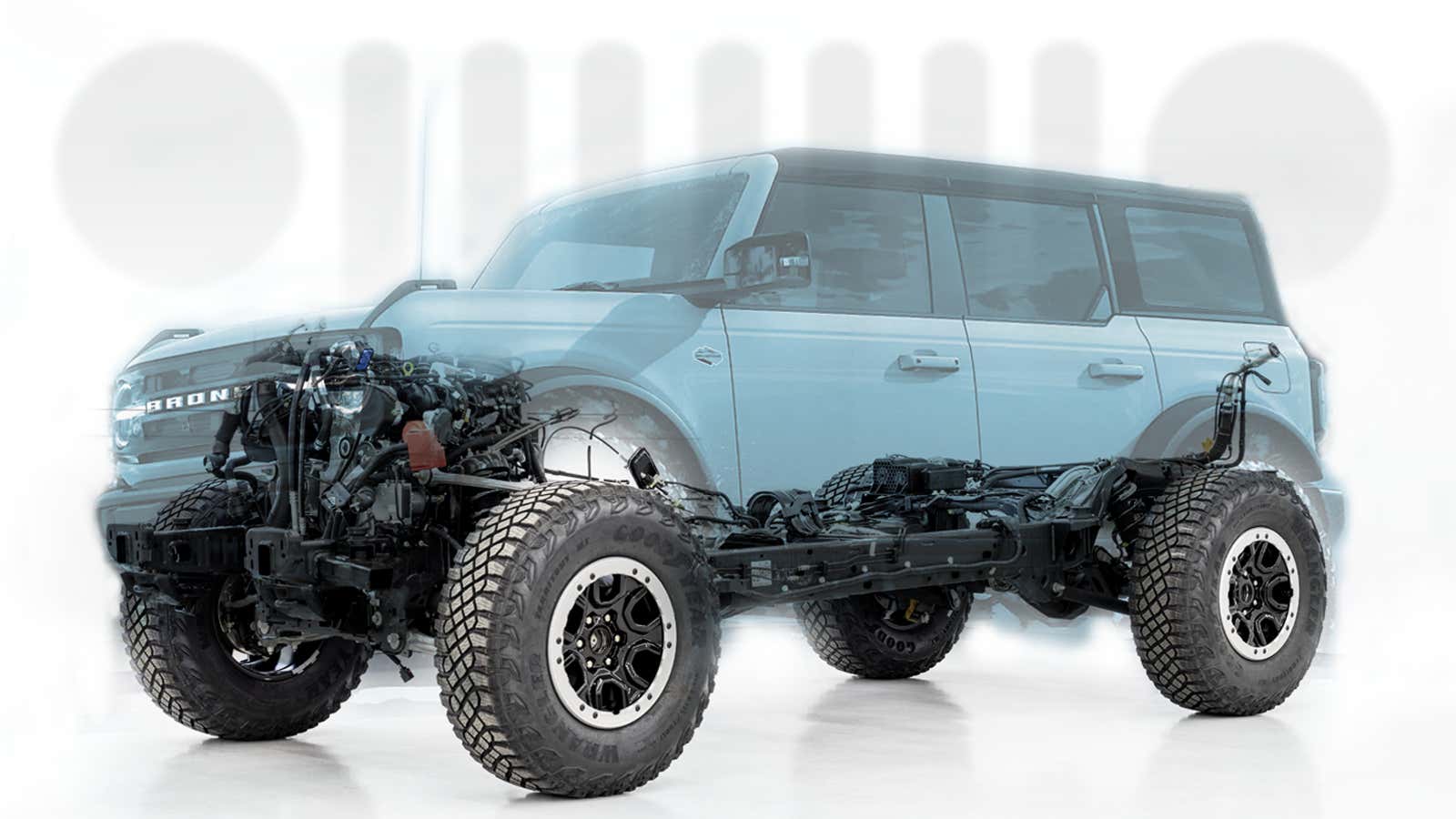To get an understanding of how the 2021 Ford Bronco will stack up against the undefeated Jeep Wrangler off-road, I had to get nerdy. I interviewed the Bronco’s Chief Program Engineer and Vehicle Engineering manager, reached out to other engineering experts in the auto industry, visited a Jeep dealership to snap photos of underbody hardware, and pored over every new Bronco image I could find on the internet. I went searching for nuggets. Here’s what I learned.
It’s been well over a decade since the Jeep Wrangler has had a true off-road competitor in the U.S. market, but now there’s a new Ford Bronco, and—with its short overhangs, tremendous ground clearance, locking differentials, and other cool off-road features—it’s clearly aiming for Jeep’s jugular. Whether it hits the mark, we can only find out after a test drive. Until then, let’s go through the hardware and get input from engineers to understand how the two vehicles compare.
Body, Frame, Suspension, Steering

Let’s first have a look at the basic architectural elements of the two vehicles, starting with the body and frame, and moving into suspension and steering.
Body, Frame
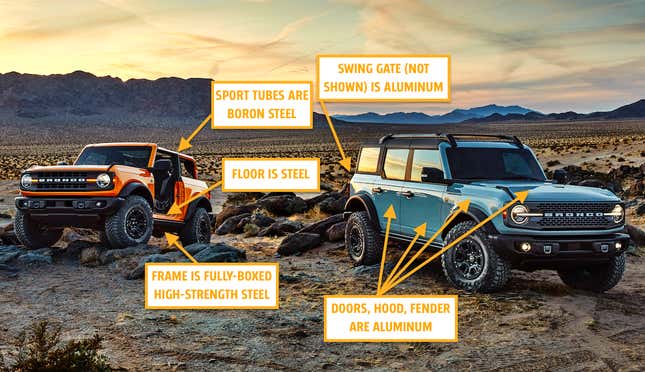
From a chassis architecture standpoint, the Bronco has a lot in common with the Jeep. Both vehicles use a body-on-frame setup, with the body made predominantly of steel (but also containing some aluminum closures) and the frame a fully-boxed, high-strength-steel ladder design.
On the Bronco, the doors, rear swing gate, fenders, and hood are made of aluminum, while the underbody is steel. The “Sport Tubes,” Ford’s Chief Program Engineer Eric Loeffler told me, are made of boron steel “so that they can take the roof crush requirements with good package size.” That’s a challenge, since they shouldn’t obstruct vision, but they need to have provisions for trim that houses side curtain airbags.
The JL Wrangler has similar body composition, with the doors, hinges, hood, windshield frame, fenders, and rear swing gate all made of aluminum, while the rest of the body is steel. (The Jeep’s swing gate does have a magnesium structure under its skin, while the Ford’s swing gate is entirely aluminum)
Suspension, Steering
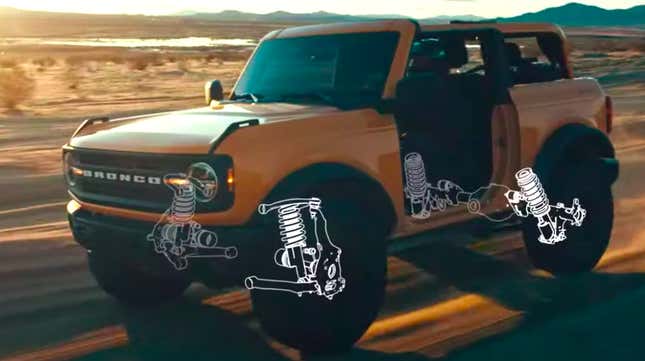
The Bronco shares its basic platform with the mid-size Ford Ranger pickup. That means the Bronco utilizes an independent front suspension consisting of two aluminum A-arms and coilovers (with Bilstein shocks on the most capable models, and lower trims sans the “Sasquatch” option getting Hitachis) that mount to the lower of those two arms. Here’s a look at the setup from a few different angles.
Front Suspension
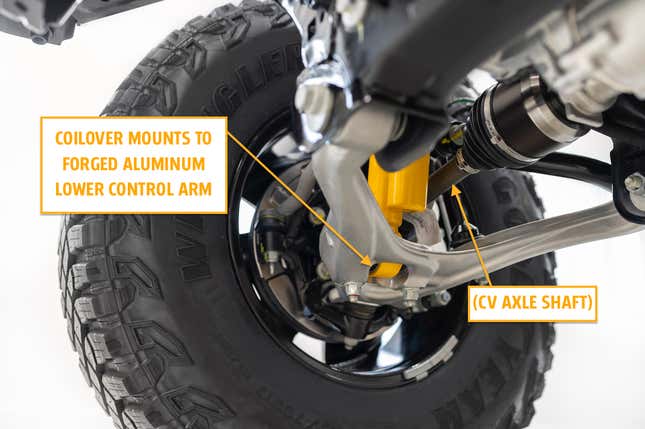


You’ll notice that in the first of the three images immediately above, I point out the CV (constant velocity) axle. This is simply a shaft whose job is to transfer power from the front differential to the front two wheels, which can obviously steer and also droop and bump when going over uneven roads. The joints inside the black rubber boots (the second boot is hidden by the shock in that first image) allow for the shaft to flex, yielding smooth power delivery when the wheels are turning and traversing road undulations.
On the Ford Bronco, those CV axles span between the wheel hub (onto which the wheels and tires are mounted) and a “Dana AdvanTEK independent front differential unit.” Here’s what this differential unit looks like:
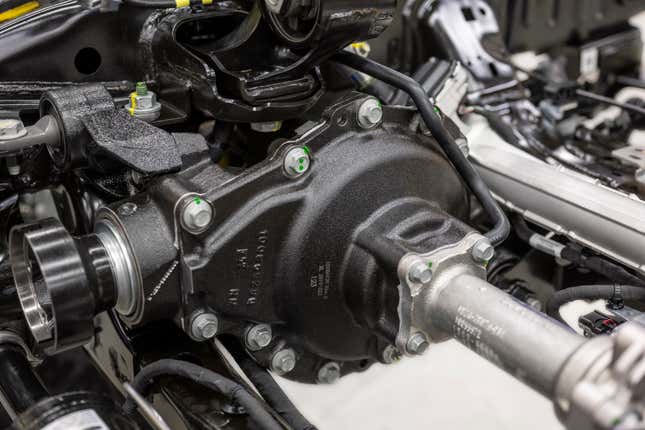
It’s just a frame-mounted, cast-iron (aluminum on locker-less models) differential, isolated with rubber bushings between it and the frame. There’s a tube coming off the passenger’s side of the housing, likely to allow for the two-axle shafts to be the same length since the differential is offset to the driver’s side so that the front driveshaft spanning between the transfer case and differential can clear the powertrain. If I had to guess, having equal length halfshafts is likely a benefit from a parts commonality and axle shaft packaging standpoint, though I suppose it could also help reduce torque steer.
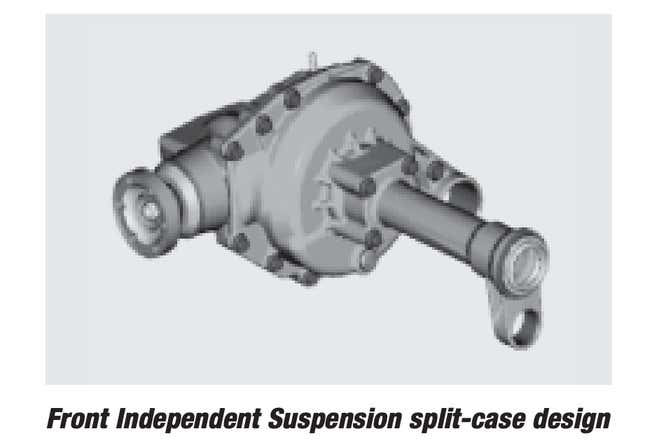
Dana labels this particular front differential unit a “split-case design,” as shown above. Here’s a look from the passenger’s side; you’ll notice the drain and fill bolts marked in yellow. After extreme off-roading in water or mud, owners may want to remove these to replace any potentially contaminated fluid. Note that Ford engineers told me the rear differential (more on it later) does not have a drain plug, meaning changing fluid will require pulling the entire cover, though that’s common on solid axles.
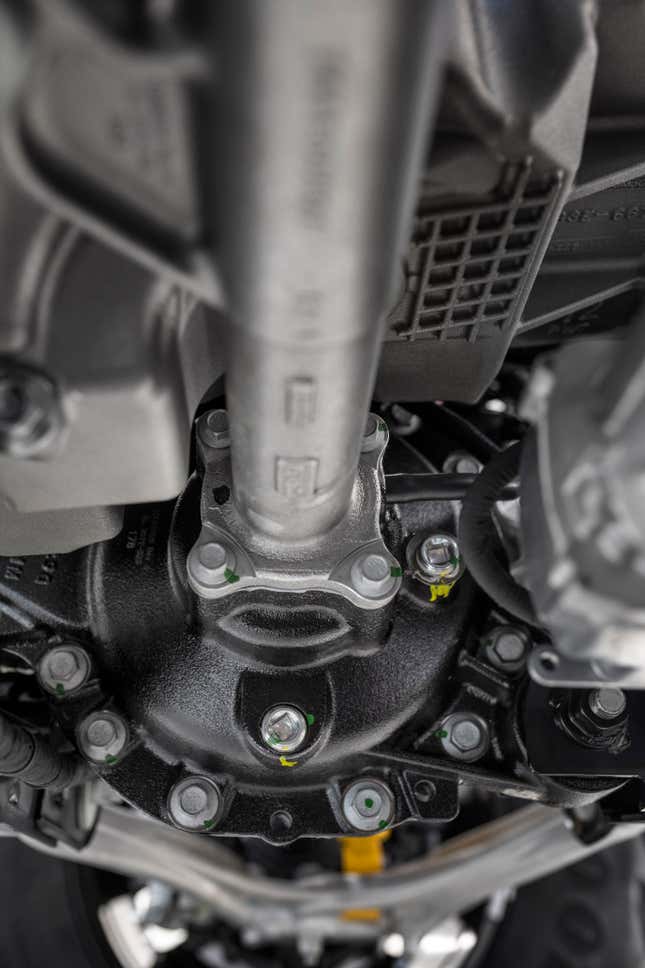
The JL Wrangler’s front suspension, by contrast, uses a five-link solid-axle design pioneered by the 1984 Jeep Cherokee XJ. (The suspension was then called “Quadra-Link.”) The setup utilizes four control arms running parallel to the SUV’s fore-aft axis—two uppers and two lowers. Their jobs are to locate the axle longitudinally and to prevent axle rotation under load. A fifth link, called the track bar, locates the solid axle laterally and spans from the frame cross-car to the axle.
I stopped by a local Jeep dealership to get a closer look at the Wrangler’s basic front suspension setup. Take a peek:

Here’s how the front axle looks from behind. All four control arms are in view, whereas only three are shown above:
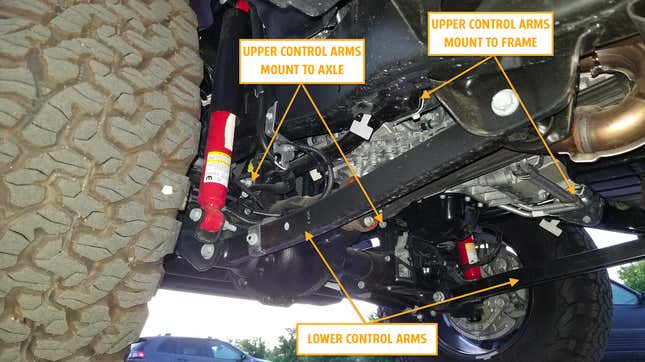
This image gives a little better look at the passenger’s side upper control arm:

The Bronco uses a coilover that mounts toward the end of each lower A-arm. The Wrangler meanwhile has a separate coil and damper (shock), as seen above. The coil mounts to the frame at a spring cup, and the solid axle at a spring perch located on top of the axle, outboard just inside the axle “C.” The shocks mount to the frame on one side and a bracket on the rear side of the axle on the other.
The Jeep’s live-axle setup is simpler than the Ford’s, since everything—the diff and axle shafts—is contained inside a big tube held to the frame with some basic steel arms. The Ford’s setup, while fairly conventional among modern cars, is considered more technically advanced, and though the independent setup has some drawbacks from an off-road standpoint, it offers several dynamic advantages. Let’s talk about those now.
Steering
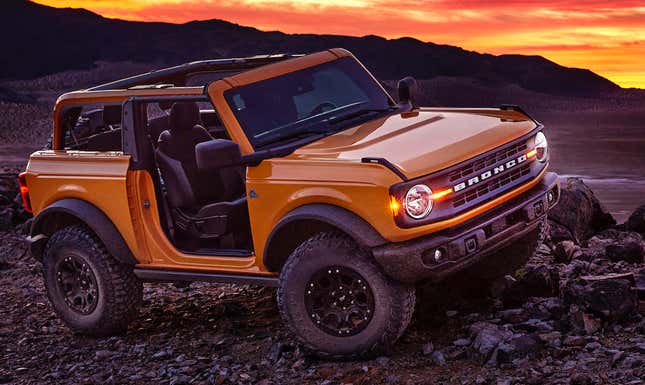
With an independent front suspension, the Ford Bronco can adopt a steering setup that’s not really possible on the Wrangler’s solid front axle: a rack and pinion. It’s a simple and clean steering design, darn near ubiquitous on all modern passenger cars, and it offers a number of advantages over a steering box. That’s what most older vehicles use, but it’s now generally relegated to heavy-duty applications.
Below is a picture I pulled off of eBay of a typical steering rack. It consists of an input shaft, which is connected to an intermediate shaft that is ultimately connected to the steering wheel. The rack’s input shaft has a pinion at its other end. That pinion’s teeth mesh with the teeth of a rack inside the housing such that turning the input shaft turns the pinion, sliding the rack axially (i.e. laterally across the car—see double-sided arrow below). This pushes and pulls tie rods connected to the steering knuckles, which rotate about ball joints and turn the wheels. (You can learn more about rack and pinions here).

I don’t see many great shots of the rack and pinion setup on the new Bronco, but here’s what I can find in the press images. This one shows the rack and pinion housing and the input shaft:
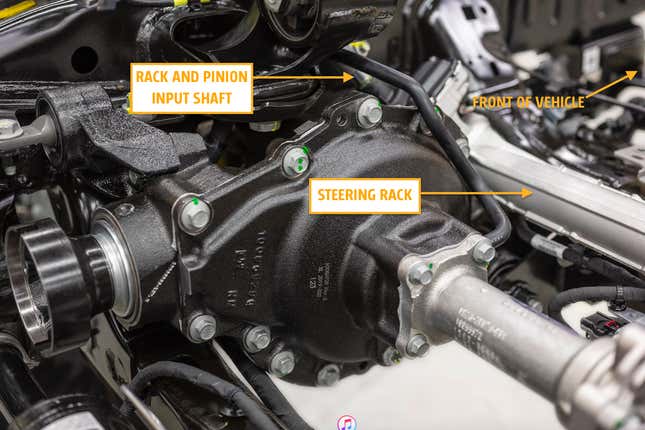
This one shows a steering tie rod on the driver’s side:
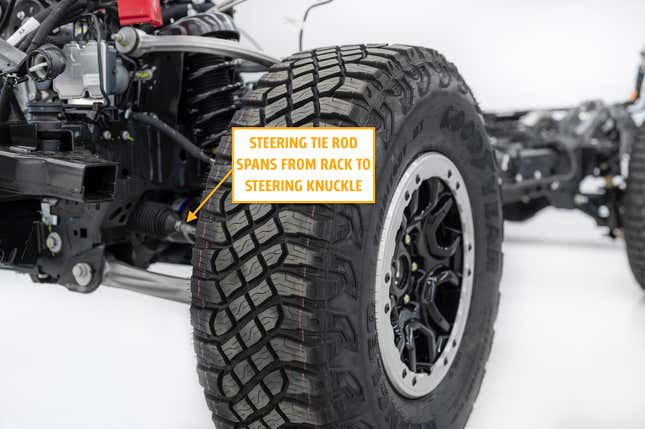
And here’s how each tie rod fastens to the steering knuckle, with this image, in particular, showing the passenger’s side:
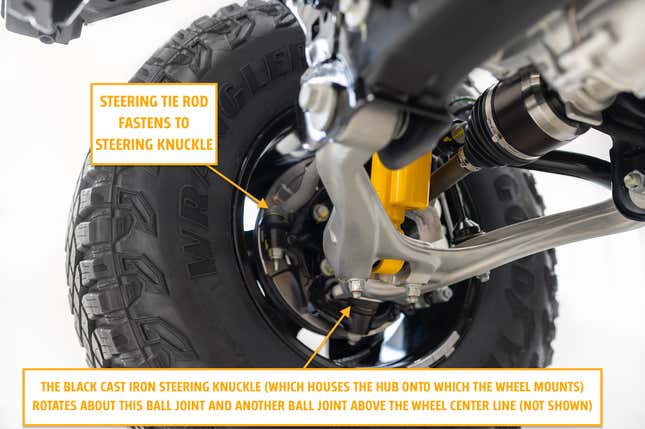
None of this is particularly novel, but it is vastly different than what’s found in the JL Wrangler, which is an old-style, “recirculating ball” steering box design. The JL’s aluminum box, shown below, mounts to the inside of the frame rail:
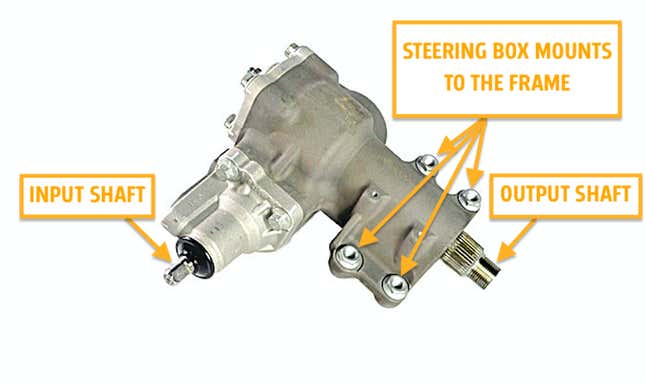
The steering box’s input shaft is hooked to an intermediate shaft, which is ultimately attached to the steering wheel. Turning the input shaft (or “worm shaft” or “ball screw”) moves a ball nut rack against a sector shaft gear, which spins the output shaft (also called a “sector shaft” or a “pitman arm shaft”).
You can learn more about steering gearboxes here, but the point is that there’s a lot going on, especially compared with a basic rack-and-pinion design. On that output shaft (or sector shaft or pitman arm shaft) is what’s called a pitman arm. As the output shaft rotates, the end of the pitman arm swings in an arc, pushing and pulling a big metal bar called a drag link, which hooks to the steering knuckle.
Here’s at the location of the steering box as seen from the front of the Jeep:
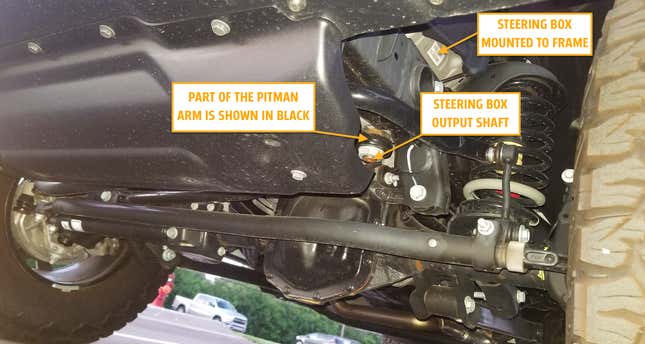
And here’s the pitman arm, which, again, connects the steering box output shaft to the drag link that connects to the steering knuckle:
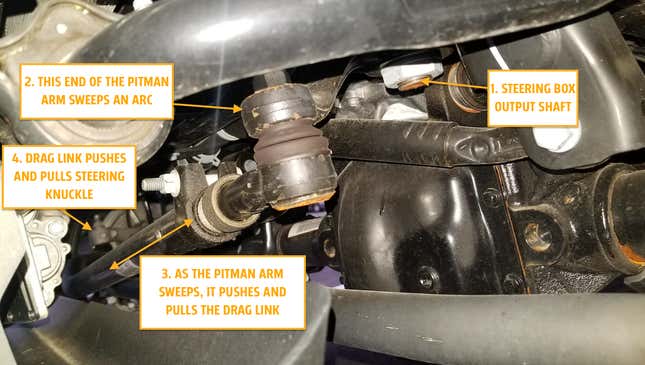
The final piece of the steering system is the steering tie rod, which connects the two knuckles so that—as the driver cranks the wheel, turning the intermediate shaft going into the steering box, turning the steering gearbox’s output shaft, sweeping the pitman arm, pushing and pulling the drag link, pulling and pushing the steering knuckle—that passenger’s side knuckle then pushes and pulls the driver’s side knuckle so that both wheels, and not just the passenger’s side, turn.
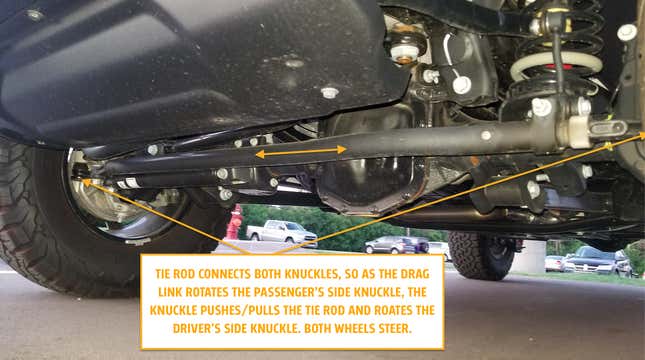
It should be obvious that the Wrangler’s old-school steering box design leaves a lot of room for “slop.” Not just in the gearbox itself, but also in all the linkages connecting that gearbox to the knuckles.
I will also add that steering boxes tend to be robust, and so do all the linkages, especially compared with what appear to be relatively spindly little tie rods coming off the Bronco’s rack, which also has exposed rubber bellows that could theoretically tear and let in water. But! The Wrangler’s tie rod, shown above, joining the two knuckles, spans nearly the entire track width. It sits low and is in a vulnerable spot.
The Wrangler’s design is beefy and works well for a solid axle with lots of articulation. That said, there are plenty of advantages to the Bronco’s rack and pinion design. To learn more, I reached out to some steering experts.
The first person I talked to has roughly 30 years of vehicle dynamics experience, having worked for a U.S. automaker and a major steering parts supplier. He wished not to be named and explained that while steering boxes are tough, they’re not exactly efficient and they do tend to wear:
The recirculating ball steering box is by far the easier design to make robust at higher loads. This is simply a steering architecture result since the box is rigidly mounted to the frame and isolated from the axles by replaceable linkages. Hence why all Class 4-8 trucks have them.
The downside of the steering box is that they [are] more prone to friction and wear due to exactly these same design criteria. They eventually wear out and the built in lash results in a less precise steering feel on road.
... But, if you break the rack housing or a tie rod you are basically done off-road. A mitigation of this vulnerability is that truck racks are usually tucked up near the engine as high as possible and covered with metal skid plates.
He then went on to talk about how modern steering racks are not only tough, but precise, lightweight, and—because they have electric motors built-in—allow for various Advanced Driver-Assist functions:
Electric Racks now have much higher load capability and provide much better steering feel and precision than the box solutions. A final huge benefit is the ability to integrate lane control and semi autonomous steering functions which a box can not provide since you need a rigid, direct steering force feedback for these ADAS solutions.
So in general, the Jeep has the traditional “off-road” solution but with it comes compromised steering feel/precision and no ADAS. The Ford has a much better steering feel plus the future proofing on the lane control abilities.
The last contrast is cost, where the rack is at least 30-40% more costly then the box, but with an overall weight savings. The steering box and linkages are much heavier.
Another engineer working for a prominent steering supplier, who also wished not to be named, did layout some more shortcomings of steering boxes. He began by describing how sloppy steering boxes can be, and how they can contribute to the dreaded “Death Wobble” that has ailed Jeeps since 1941:
The predominant [advantage to a rack and pinion design] is in overall steering feel and performance. In a rack and pinion, both wheels are controlled by a common component, whereas the steering box requires one wheel to turn the other, which can be a huge liability for steering feel because of the chain of effects to steer everything. Even the stiffest steering box systems have far more lash due to the lengths the movements and adjustments need to travel and generally larger tolerances. This is also a component in the dreaded “death wobble” that still plagues even the JL. It’s virtually impossible to get a death wobble on a rack system because of how little lash and flex there is in the control system.
He went on to echo the previous engineer’s sentiments about Advanced Driver-Assist limitations, weight savings, and efficiency:
Another major item is that the Bronco probably uses an electrically-powered steering system, not a hydraulic system. Some commercial trucks are now using electrically assisted steering boxes, but as far as I know, JL is still very much hydraulic. This limits FCA’s ability to include many of the convenience and safety features that are included in today’s modern cars and trucks, like Lane Keeping Assist and Automatic Parking, in addition to having different steering tuning for different conditions (snow, sport, etc) that is all available for the Bronco. EPS also improves fuel economy, power availability, and overall weight because the steering pump and hydraulic circuit components are removed from the vehicle. This gains a few HP and reduces friction/drive losses by not needing to be constantly driving another hydraulic circuit.
But he also echoed that steering boxes are pretty dang tough:
What you do gain with a steering box is that it’s incredibly durable and comparatively easy to fix in the field. Most steering boxes are cast iron, the linkages are also iron or steel, and everything can be welded back in a pinch. Hoses can be taped up. Pumps can be located high on the engine to keep it safe from major impacts. These durability concerns can be mitigated on a rack system by being packaged up in the vehicle and protected by skid plates and other more sacrificial underhood components, (exhaust, primarily), but it’s still going to be a lower component under the hood. Also, for assist, EPS is really all or nothing - you can’t fix it on the trail if you lose your motor. EPS motors aren’t generally sold separately and will require dealership re-calibration and maybe a whole new system even in the event of a motor failure. It’s all still going to be steerable without assist, but whereas a Wrangler can potentially gain back its power assist with some basic repairs, you’re SOL with an electric system failure.
The steering engineer finished by saying that he thinks the Bronco will be “a huge winner because it will have more responsive steering feel and all of the fun, fancy assist features that are almost standard on new cars these days.”
Advantages Of The Bronco’s Independent Front Suspension Over The Wrangler’s Solid Front Axle
Other than the advantages associated with a rack and pinion steering design, what other benefits does an independent front suspension offer over the Wrangler’s solid axle?
It was clear to me during our interview that the Bronco’s Chief Program Engineer Eric Loeffler was taking a dig at the Wrangler when he told me: “What we’re after with Bronco is not to be a one-trick pony but basically to... have the ability to use the vehicle in a variety of ways but be competent in all ways.”
The Bronco, Ford wants to make clear, is about more than just excelling on the rocks, but about conquering the street, the dunes, and a variety of different driving environments.
“There’s certainly relative to our competitors a lot of areas that we’re going to excel where they just can’t,” Loeffler said, confidently.
When I asked if parts commonality (I was thinking particularly of the Ranger, since the Bronco shares its architecture) drove the independent front suspension decision, Loeffler said it was about more than that. He says if Ford had wanted to do a solid axle, it would have. The company’s thought comes down to: “What does the product need to be to serve the customer’s needs before we get into the constraints of the financials.” Referring to a solid front axle: “It’s just not something that was a critical need for the type of product that we were trying to engineer and provide to the customer.”
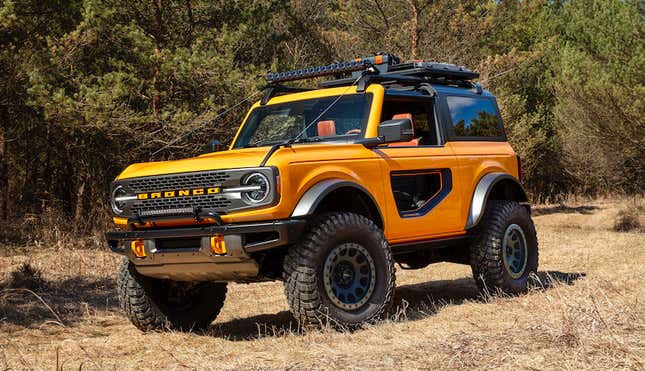
When I asked Jamie Groves, Vehicle Engineering Manager for the Bronco, about the advantages of the rack and pinion steering over the Jeep’s steering box, he broke down the advantages of the independent suspension in general.
“The rack and pinion and just the architecture itself lends itself to much better on-road and off-road vehicle dynamics because you’re better able to control the kinematics and compliance of the wheels,” he said, later telling me that the unsprung weight of the independent design is significantly lower than that of a solid axle. This is good, as it makes it easier for surface inputs to accelerate the wheels/suspension bits against the specially-tuned springs/shocks.
Here’s Ford’s official line on how lower unsprung weight gives the Bronco an advantage:
Less unsprung weight means less work for the shocks and springs to keep the tires in contact with the road over bumpy surfaces. Reducing unsprung weight is key to improving handling. If unsprung components have a high mass, they are harder to accelerate/decelerate and therefore more difficult for the suspension to maintain a consistent tire load.
“We’re night and day from the competitor in regards to just on-road comfort and handling, steering feel, and we’ve got lots of experience doing rack [electric power-assisted steering] on virtually every product... we get good off-road and off-road performance out of it, and the ability to do lots of things with tuning and change things with different drive modes,” he said.
Groves mentioned the Wrangler’s steering wander. “The Bronco just, it tracks. It just has great straight-ahead stability and feels like a modern vehicle,” referring to the difference in steering experience between the two vehicles as “night and day.”
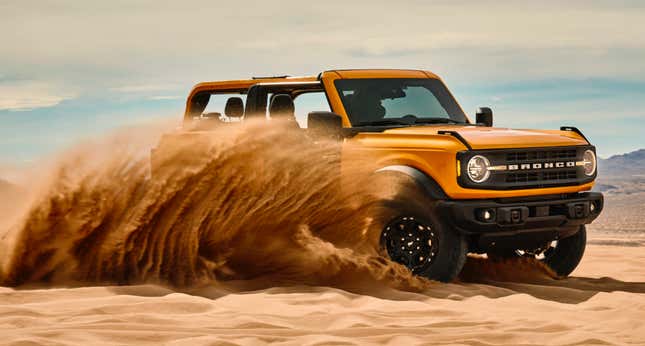
“The ride on-road as well is very, very good. Even the least critical customer is going to notice the difference just in terms of on-road steering and handling performance...and ride as well,” he said. This should be no surprise, as a solid axle connects both front wheels with a big steel tube, so a bump on one side of the car gets translated to the other, often yielding “head toss” for the occupants.
Loeffler chimed in, and said, when it comes to off-roading, the Bronco will excel, particularly well when speeds get high. “Basically, when you do anything at more speed... we totally nailed that in terms of vehicle performance capability.”
Disadvantages Of The Bronco’s Independent Front Suspension Versus The Wrangler’s Solid Axle
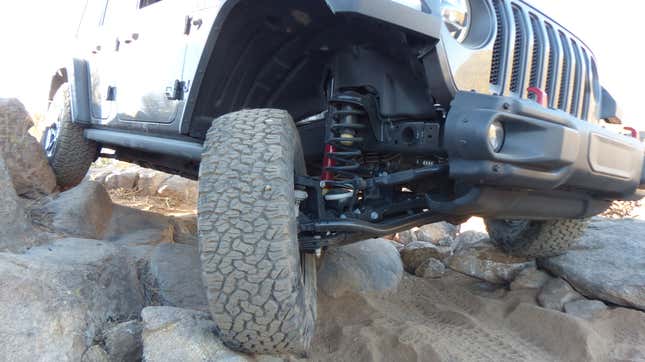
But there are some distinct advantages of a solid front axle for off-roading.
The Jeep’s axle shafts are housed inside of a big, strong steel tube, protected against the elements, whereas the Bronco’s axles are exposed. What’s more, whereas the Jeep utilizes universal joints to allow for smooth power delivery to a wheel that’s turning and bouncing over terrain, the Bronco uses CV joints. Among hard-core off-road enthusiasts, many prefer universal joints, as they don’t have rubber boots that can tear and compromise bearings, and they can be easily replaced on the trail using nothing more than a big rock and a few sockets.
Here’s a look at one of the Bronco’s exposed front CV axles and their boots:
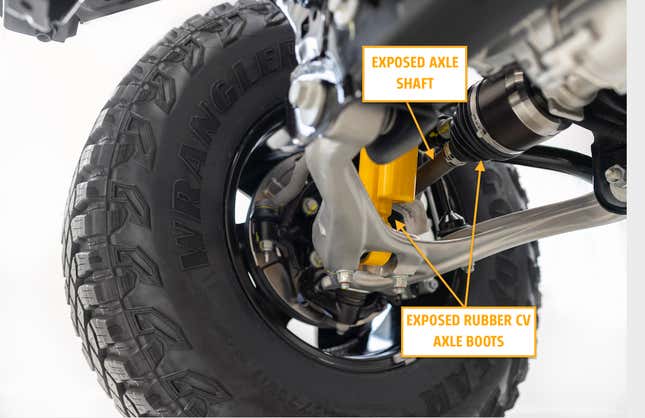
By contrast, the only exposed part of the (non-full-time-four-wheel-drive) Jeep Wrangler’s front axle shafts are the beefy universal joints connecting the yokes on the axle shafts.
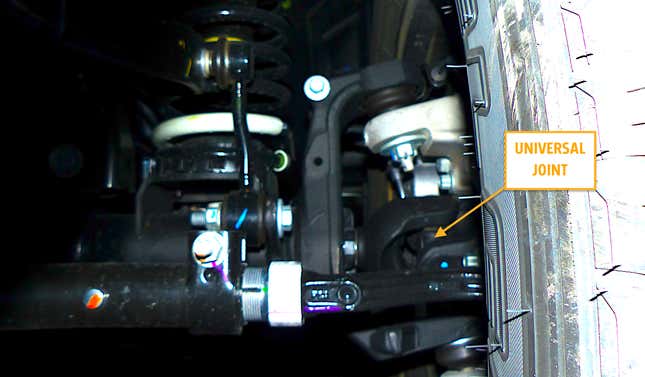
Of course, when I asked Ford about durability disadvantages of an independent front suspension compared with a solid front axle, the company made it clear that it has gone to great lengths to test the Bronco’s strength:
Every Bronco goes through rigorous testing to ensure long-term off-road performance and durability. Bronco leverages Ford’s Built Ford Tough durability and performance testing and takes it further off-road with Built Wild Extreme Durability Testing in the harshest environments, including trails from King of the Hammers off-road competition.
Other than durability (again, it’s hard to beat the durability of a giant steel tube, though I bet the Bronco’s forged aluminum lower A-arm is tough enough), another advantage of a solid axle is articulation. And Ford has no problems admitting this.
“Versus a Rubicon with a bar disconnected [compared] to our Badlands with the bar disconnected, we’re not gonna be as high a score as they are,” Jamie Groves, vehicle engineering manager for the Bronco told me about the Bronco’s Ramp Travel Index versus the Jeep Wrangler’s.
Ramp Travel Index is an indication of a vehicle’s suspension articulation capabilities, and Ford rates the Bronco’s at up to 700 on the Badlands trim in two-dour guise and up to 620 for the four-door Badlands.
Jeep doesn’t publish its RTI score, though Fourwheeler tested a JL last year, and measured 693 on the four-door (though both tests were done on 20-degree ramps, comparing RTI scores achieved with different equipment is unadvisable, but this comparison may be a decent guess at the delta in flex between the vehicles). “We won’t be as good as the direct competitor, but I’d say we’re better than anything else in the market other than that specific one,” Groves admitted.
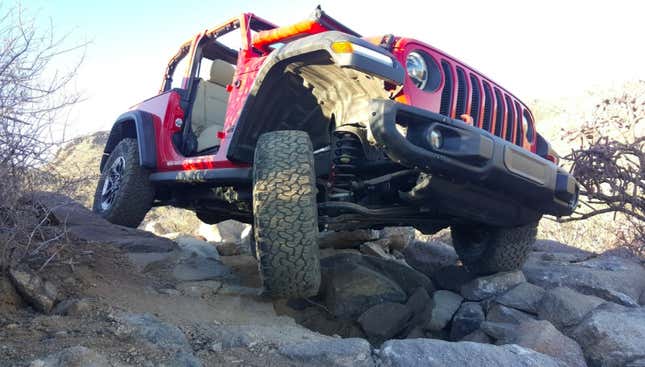
Speaking of the Bronco’s flex, the vehicle comes with a front hydraulic sway bar disconnect feature, shown below. (Ford did something to the rear sway bar to improve articulation as well. Continue reading to learn about that). Ford refers to it as “semi-active,” saying it can disconnect and reconnect even when the vehicle is flexing. A Ford representative described the “semi-active” system’s mode-of-operation in an email, writing:
The bar disconnects once you enter rock crawl mode, or if you press the bar disconnect button to activate it manually: the bar will be disconnected all the time the vehicle is below the speed threshold for bar to be disconnected (20mph). It will automatically disconnect / reconnect as the vehicle passes below / above the threshold. The disconnect/reconnect is controlled hydraulically, thus it will not block when under load.

I’ll keep bugging Ford to hear more about the internal mechanical intricacies of this “Hydraulic Stabilizer Bar Disconnect,” and how it differs from the Jeep Wrangler Rubicon’s electronic sway bar disconnect (shown below), which—at least on the previous-generation JK—is known to be fraught with issues, and can only be disconnected and reconnected on flat ground. (If you’re wondering how the Jeep’s sway bar disconnect works, check out this link. There’s an electric motor that moves a collar against a spring, disconnecting two sections of the sway bar).

Lift Kits
Another advantage of the solid axle outside of articulation and (theoretically) durability is how easy they are to lift. People in the off-road scene love to lift their vehicles and slap on bigger tires, and that’s incredibly easy with a solid axle since the differential always remains on the same axis as the wheels. With independent suspension, installing taller springs moves the wheels down relative to the frame, where the diff is mounted. What this means is that the angle of the halfshafts (CV axles) from the differential to the wheel hub gets steeper, and this can cause issues when it comes to CV-joint longevity.
Ford admits that a solid axle offers advantages when it comes to installing lifts. “In the front, yeah, with the IFS, basically... you can either just do the re-trim—the ride height adjustment, which folks... do with F-Series and Raptor,” Groves told me. When I asked him what he meant by re-trim, he answered: “People will put taller springs in... and sacrifice a bit of rebound travel to get a bit more height and clearance.” This could allow them to go up to the next tire size, and get the look they want.
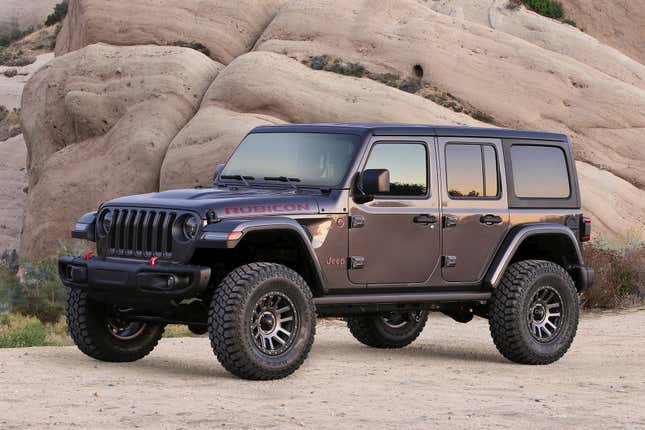
But for those who don’t want to sacrifice rebound travel or who want even more lift, the next step is to install longer control arms.
“The next step is putting longer arms on the truck with, again, kind of the—think of it like the Raptor versus standard F-Series way of handling the ride height increase and the tire package increase. And we’ve got partners that we’re working within the aftermarket where stuff like that’s gonna be available,” Groves said.
The point, there, is to keep the CV joint angles close to the same as stock. “If the CV joints maintain common angles, but you go wider, then by geometry, you get more height and travel,” he told me.
“That’ll get us so far, and then the guys that really want to go all-in, they’ll do portal [axles].” (Portal axles allow the end of the axle shaft to be offset, sitting higher than the center of the wheels. This is what you see on, say, Unimogs, or the lime-green AMG G-Wagen that patrols your local nightclub district.)
Rear Suspension

In the rear, the Ford Bronco uses a Dana 44 solid axle connected to the frame via five-links: a track bar, two lower control arms, and two upper control arms. The track bar locates the axle laterally, while the control arms constrain it longitudinally and mitigate axle wrap. Coilovers with Bilstein shocks are mounted at shock towers on the frame side and at axle-mounted brackets on the other.
Those optional monotube Bilsteins, by the way, are three-position dampers, or as Ford’s marketing calls them “Long-travel position-sensitive Bilstein dampers with end-stop control valves.”
Eric Loeffler, Chief program engineer for Bronco, told me they increase damping force near the end of travel, and that they’re “very effective in smoothing out large undulations in whoops and jumps, so you don’t get that crash-through feel in jounce or the topping out in rebound.” They’ve got piggyback reservoirs which should help them run cooler, and they look quite a bit different than the standard monotube shocks on the JL Wrangler.
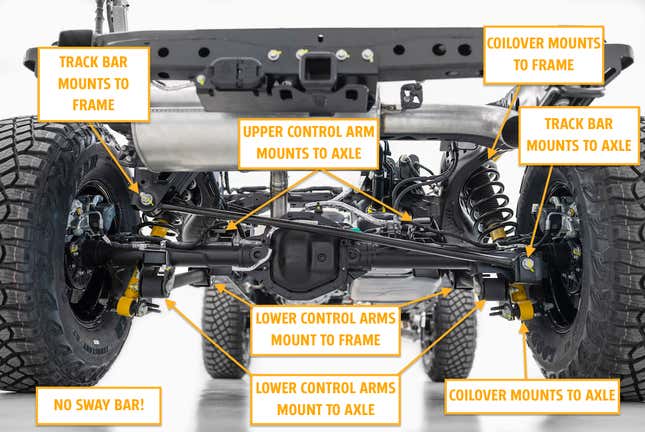
Here’s another look at the rear axle as seen from the front:
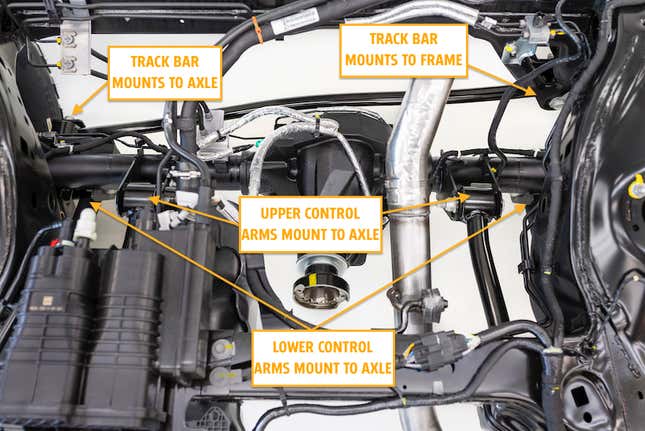
And here’s a closer look at the driver’s side upper control arm mount:
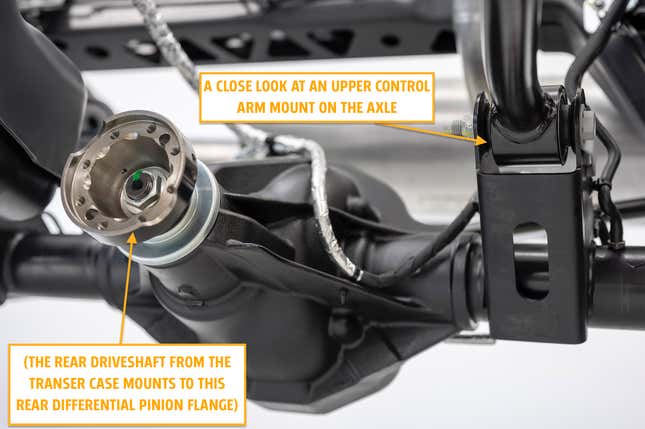
This is the exact same suspension type as the Jeep Wrangler JL, though the execution is remarkably different. Below is the Jeep Wrangler JL Rubicon’s rear axle. It, too, is a five-link Dana 44, though you’ll notice how different the mounting locations are.
For example, the track bar mounts to the frame on the passenger’s side on the Wrangler, whereas on the Bronco, it mounts to the frame on the driver’s side. As for the axle mount for the track bar, notice how much farther outboard the Bronco’s is than the Wrangler’s, which is located up high and inboard of the driver’s side lower control arm mount. On the Bronco, the track bar mount on the axle is located on the axis of the axle, and very far outboard on the passenger’s side.

Here’s a different angle that shows the JL’s passenger’s side upper control arm a bit better:
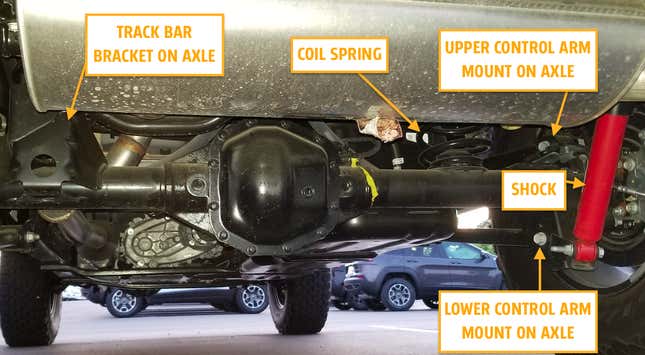
And here’s a look at the rear axle from the front:
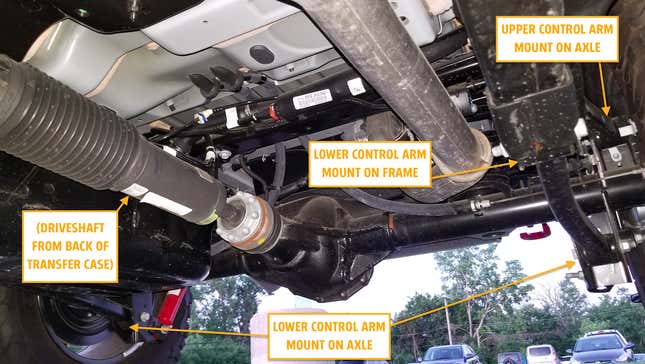
As for the upper control arm mounts, the Wrangler’s are way outboard, whereas the Bronco’s are inboard. Lower control arm locations on the axle are similar, as are shock mounts, though the Bronco uses a coilover setup, so the Ford lacks the coil spring purchases seen at the top of the Wrangler’s Dana 44.
Looking at the two rear suspensions, the Bronco—while sharing the same basic five-link design as the Wrangler—clearly has the cleaner and more elegant setup. Without a separate shock and spring, like on the Wrangler, the axle doesn’t need spring perches up top. Plus, the Bronco has no rear sway bar, which also helps clean up the axle a bit.
Ford left the sway bar off the rear axle to aid with flex. “It was primarily to get improved articulation,” Groves told me. “We know with the IFS that we will not get quite as far as the... competitor for articulation, so we went as far as we could to maximize what we could get out of the architecture... [removing the rear sway bar] was one of the knobs.”
He also mentioned that having the coilovers far outboard on the axle offered dynamic advantages. “Certainly... having the damper and the spring as far outboard as it is has been a help from a dynamics perspective, and from an off-road perspective,” he said.
When I sent a follow-up email asking Ford to elaborate a bit, the company responded with a note about motion ratio, which describes the ratio of the spring’s displacement to the wheel’s displacement (you can imagine how, if a wheel goes up on a solid axle, a spring close to the center of the axle won’t compress much. This would have a low motion ratio). It’s sort of like the “lever arm” the wheel input has when working against the spring. From Ford:
Outboard coilovers help with motion ratio in roll. Motion ratio is an effectiveness of the spring and damper. In pure vertical, they can be located anywhere on the axle and have a good motion ratio/effectiveness, but in roll, further outboard improves motion ratio and allows you more axle control without having to upsize components and add weight. As you improve motion ratio, the axle control is more fluid and less abrupt for a given level of spring rate and damping control.
Ford says having the shock and spring close to the wheel input provides dynamic advantages; the way I read this, the setup lets Ford reduce body roll without having to make the springs too stiff (I’m far from a dynamics expert, so I’ll be reaching out to Ford and industry engineers to get a little more clarity on the advantages of getting that motion ratio close to 1).
Powertrain and Drivetrain
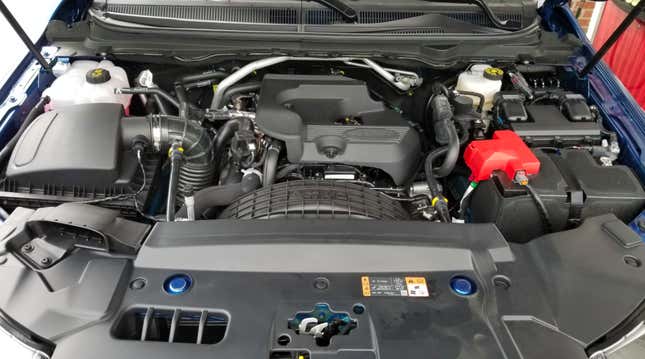
Under the hood of the Ford Bronco is a 2.3-liter direct-injected turbocharged inline-four making 270 horsepower and 310 lb-ft of torque—the same numbers as the Ford Ranger (whose engine bay is shown above).
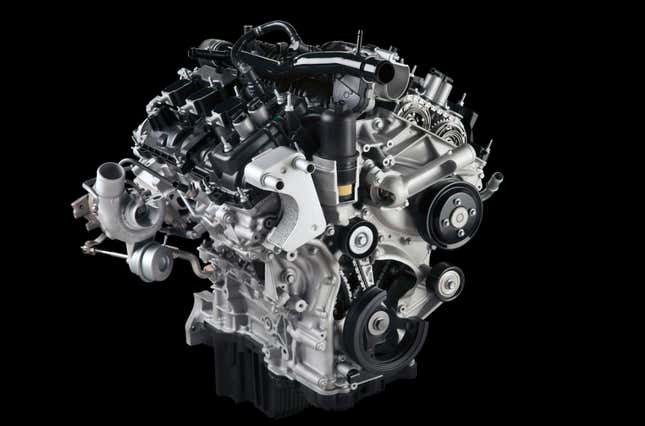
The optional engine is a 2.7-liter direct and port-injected turbocharged V6 making a projected 310 HP and 400 lb-ft of torque. (The one shown above is the 2.7 EcoBoost out of a 2016 Ford F-150).
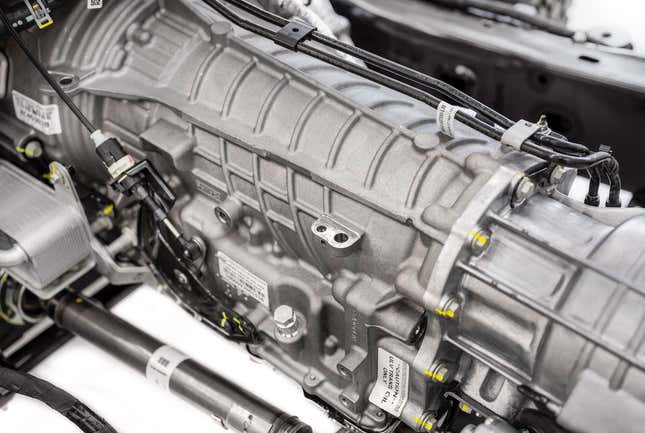
The smaller engine can be mated to a seven-speed Getrag manual transmission (which is available on both two and four-door models and is shown below). It does not contain a direct-into-box shifter, but rather, is cable operated like the JL Wrangler’s transmission, with Ford telling me why via email:
The manual transmission uses cables from the shifter to the transmission to help isolate NVH from the driveline without affecting the position of the shifter.
Both of the Bronco’s motors can be bolted to the same 10-speed automatic (shown above) offered in the Ranger.

Hooked to the back of those transmissions are two available transfer cases. The standard one is a part-time unit that allows for shift-on-the-fly (via an electric switch) into four-wheel drive. Its low-range ratio is 2.72. The other transfer case, shown below, offers a “4A” mode, which allows for electromechanical actuators in the transfer case to automatically engage four-wheel-drive “high” mode from the two-wheel-drive when conditions require it. This transfer case has a 3.06:1 low range ratio.
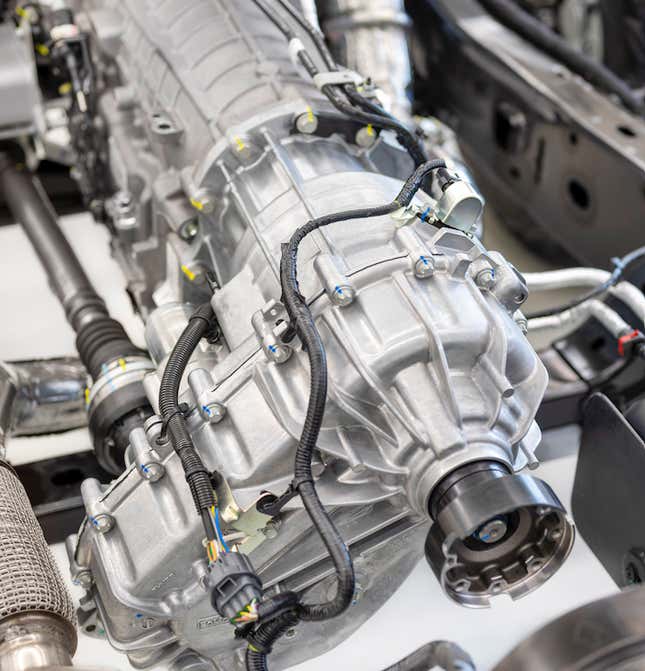
By comparison, the Jeep Wrangler offers three engine options, two transmission types, and three transfer cases. There’s this 3.6-liter naturally aspirated V6 making 285 horsepower and 260 lb-ft of torque:
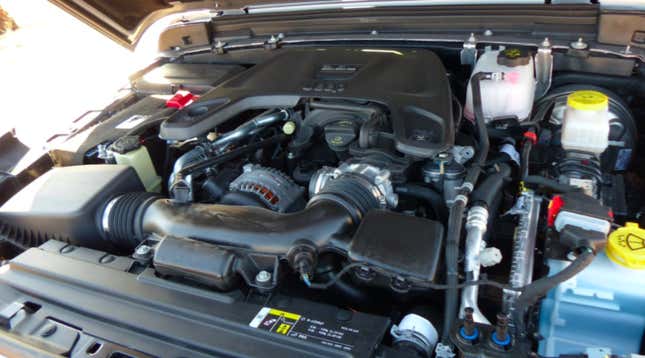
There’s this mild-hybrid 2.0-liter turbocharged inline-four making 270 horsepower and 295 lb-ft of torque:
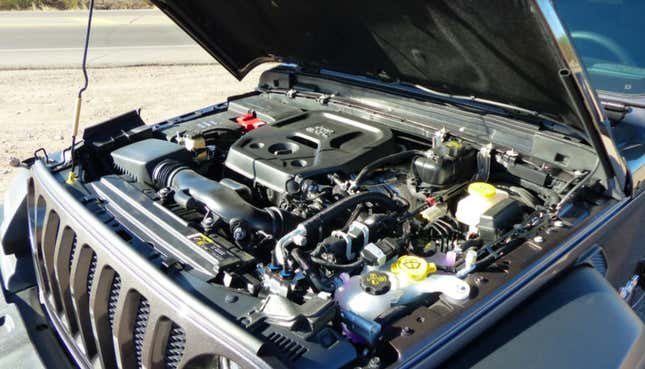
And there’s a 3.0-liter turbodiesel making 260 horsepower and 442 lb-ft of torque:
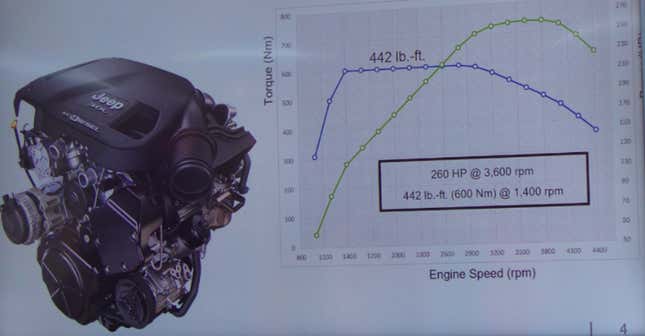
Only the 3.6-liter can be mated to a (rather ho-hum) Aisin D478 six-speed manual transmission, whose shifter you can see here next to the manual transfer case lever. The Bronco’s 4x4 engagement is via an electric switch (shown a few photos down), which diehards will decry as a possible failure mode. I asked Ford if one could shift into four-wheel drive using a wrench if the actuator fails; the response was “We do not recommend this.”:
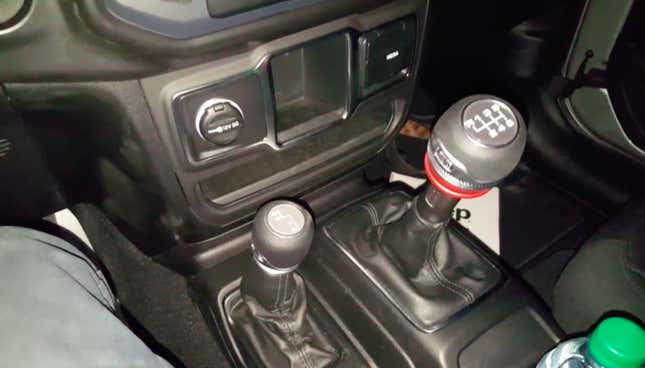
The Jeep’s 2.0 turbocharged gas motor and 3.0 turbodiesel come mated only to different variants of essentially the same eight-speed automatic transmission (the 850RE is the only transmission available for the 2.0 and it’s optional on 3.6. The beefier 8HP75 is the sole transmission for the 3.0 diesel).
Bolted to the transmissions are three transfer case options: Command-Trac, Rock-Trac, and Selec-Trac. The first is the stock transfer case on the base models and contains a 2.72:1 low range ratio, the second is standard on Rubicon and has a 4:1 low range ratio, and the full-time Selec-Trac is optional on Sahara and also has 4:1 low range.
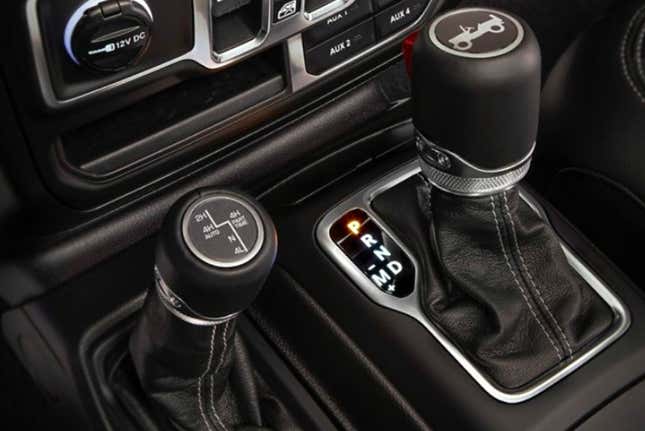
Note that, as shown above, even on the full-time “auto” transfer case, which apportions power front to rear as needed based on what’s happening where the tires meet the road, there’s a manual lever. On the Bronco, there’s the knob shown below.:
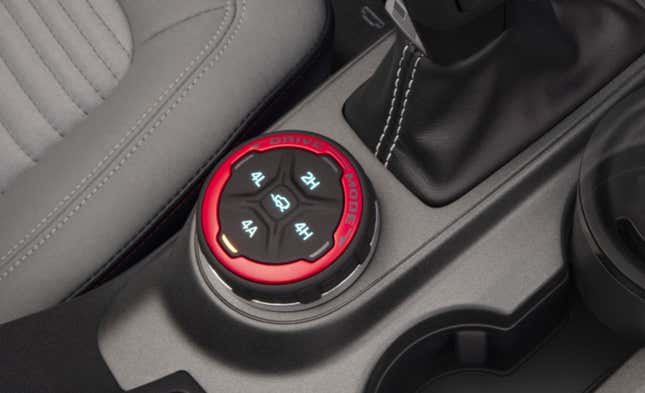
From the transfer case, power goes to Dana 44 axles in the case of the Wrangler Rubicon and Bronco, with the Bronco’s being an independent-type front diff housing. Ring gear sizes, in case you were curious, are 220mm in the rear, 210 upfront on both the Wrangler Rubicon and Bronco Badlands (and Sasquatch Package). On other less-off-road-ish trims, though, the Wrangler goes to a 186mm ring gear up front and 200mm rear, and Bronco goes to 190 front but keeps it 220 outback.
Crawl Ratios

Crawl ratio is the factor by which engine torque is multiplied before arriving at the wheels. A large crawl ratio essentially provides a vehicle with more “thrust” to traverse steep obstacles without the driver having to apply more engine revs to build torque. (You can read all about crawl ratios and off-road gearing in my explainer.)

In a four-wheel-drive vehicle with a two-speed transfer case, engine torque first gets multiplied in the transmission, then in the transfer case, then in the differentials. (It’s also in the torque converter on automatic-equipped vehicles, but we don’t count that.) So, a crawl ratio is simply defined as the product of those gear reductions.
Let’s calculate the crawl ratio for the JL.

The manual transmission’s first gear ratio is 5.13. Multiply this by the 4:1 low-range ratio and 4.1:1 axle ratio on Rubicon, and you arrive at a crawl ratio of about 84:1. In non-Rubicon trim with a 3.45 axle ratio and the basic Command-Trac 4x4 system with a 2.72 low range, that drops to 48.
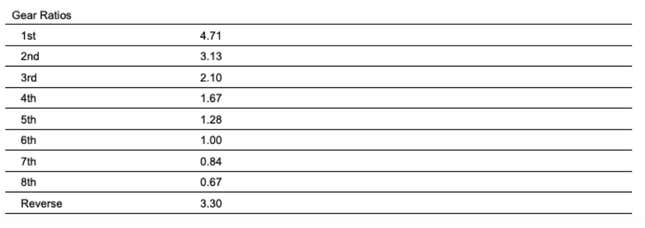
As for the automatic, the first gear ratio is 4.71:1. Multiply that by 4.1 and 4.0, and you get a 77.2 crawl ratio. In non-Rubicon trim with a 3.45 axle ratio and the basic Command-Trac 4x4 system with a 2.72 low range, that drops to 44.
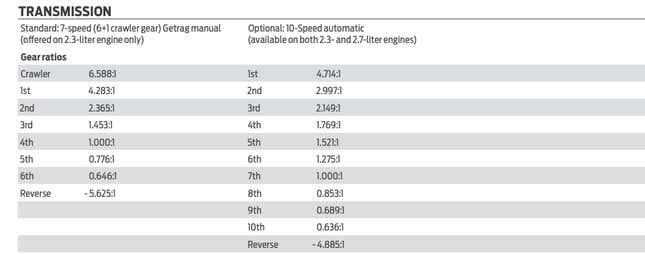
The manual Bronco smashes the Jeep’s figures.
The manual’s 6.588:1 first gear, when multiplied by the 3.06 low-range ratio in the optional automatic four-wheel-drive system and the absurd 4.7:1 final drive ratio available on Badlands yields a crawl ratio of nearly 95. On a base Bronco with the part-time transfer case (2.72:1 low range ratio) and the accompanying 4.46:1 axle ratio, that drops to about 80.

The automatic, with a 4.714:1 first gear ratio, and also a 3.06 low range ratio and 4.7:1 axle ratio (part of the Sasquatch package, which is automatic-only), can be had with a crawl ratio as high as about 68—not as high as the automatic Jeep Wrangler Rubicon’s. On the base model with the 2.72 low-range part-time transfer case and its accompanying 3.73:1 axle ratio, the crawl ratio drops to 47.8.
In summary:
- Ford Bronco Automatic Crawl Ratio Range: 48-68
- Jeep Wrangler Automatic Crawl Ratio Range: 44-77
- Ford Bronco Manual Crawl Ratio Range: 80-95
- Jeep Wrangler Manual Crawl Ratio Range: 48-84
It’s worth mentioning that crawl ratio does not equate to “better,” as tire size factors in (you want a larger ratio for bigger tires to get the same “thrust”) and also, at a certain crawl ratio, you achieve diminishing returns.
Geometry
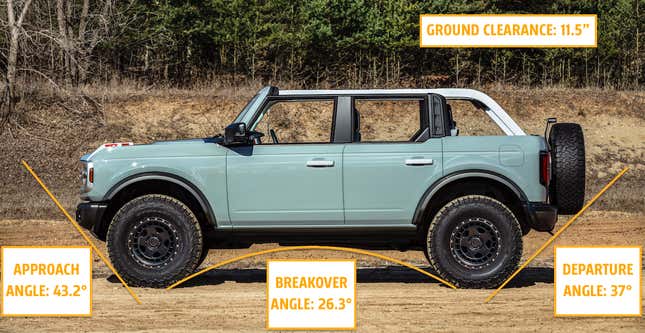
I’ve said this many times before as an auto journalist, experienced off-roader, and person deeply embedded in the Jeep off-road community: The most important attribute of any off-road vehicle is geometry. Locking diffs, fancy traction control systems, nice tires, skid plates, disconnecting sway bars—all of that is unimportant if the vehicle’s basic geometry prohibits it from traversing uneven terrain without damaging bumpers or rocker panels.
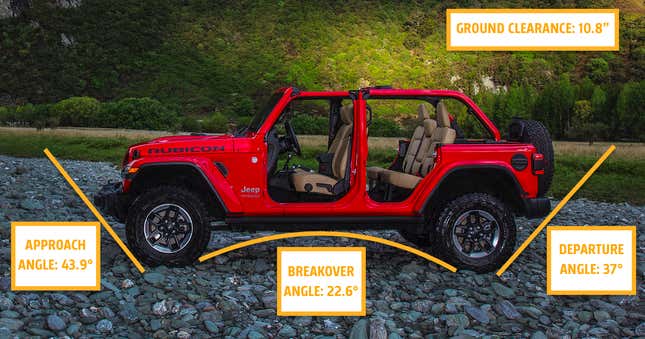
With the Sasquatch package and its 35-inch tires, the Bronco four-door has a 43.2-degree approach angle, 37-degree departure angle, and 26.3-degree breakover angle. Those are about the same figures as those of the Wrangler four-door, though the Ford’s breakover angle is significantly better, plus it has seven-tenths of an inch more ground clearance than the Jeep.
The base Bronco four-door has a 35-degree approach angle, 29.7-degree departure angle, a 20-degree breakover angle, and 8.3 inches of ground clearance. The four-door Wrangler Sport (that’s the base trim) has a relatively high approach angle at 41.4 degrees, and it’s got a 36.1-degree departure angle, 20.3-degree breakover angle, and 9.7 inches of ground clearance.
Clearly, Ford is leaning hard on those optional 35s to get the Bronco its impressive off-road geometry, because base Wranglers seem to have better angles and clearance than base Broncos.

Comparing the two doors yields similar results: The Bronco and Wrangler are well-matched in approach and departure angles, though the Ford can theoretically crest steeper hills thanks to a better breakover angle. Plus, it has eight-tenths of an inch more ground clearance.
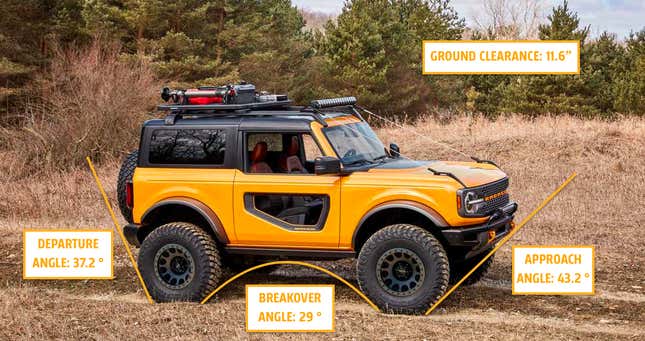
Again, without the 35s, the Jeep has the advantage. A base Bronco has just a 35.5-degree approach angle, 29.8-degree departure angle, 21.1 degree breakover angle, and 8.4 inches of ground clearance. By contrast, even a Wrangler Sport has a 41.1-degree approach angle, 35.9-degree departure angle, 25-degree breakover angle, and 9.7 inches of ground clearance.
Overall body dimensions are also important when considering off-road nimbleness. The Wrangler two-door has a wheelbase of 96.8 inches, an overall length of 166.8 inches, an overall width of 73.8 inches, and an overall height of 73.6 inches. The Bronco two-door’s wheelbase is nearly four inches longer at 100.4 inches, the Bronco is also eight inches longer at 174.8 inches (Badlands model), it’s roughly the same height, and it’s wider at about 76 inches (or 79 on the Wildtrak).
The four-doors are roughly the same width and height as the two-door variants, though the four-doors obviously add wheelbase and overall length. The JL Wrangler’s wheelbase grows to 118.4, and its overall length increases to 188.4. The four-door Bronco’s wheelbase is smaller at around 116, and its overall length reaches roughly 190—so, a bit longer than the Jeep.
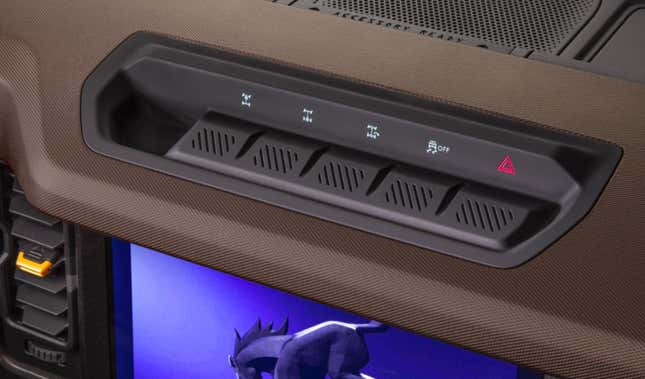
Another important indicator of “nimbleness” is the turning circle. The Jeep’s is 34.5 feet on the two-door and 39.4 on the four-door. Ford hasn’t published its turning diameters, but it does mention that it has a feature called “Trail Turn Assist,” which applies brakes to the inside rear wheel to tighten turning while off-road. The indicator light for this feature is shown in the photo above, which shows the top of the dash. (Trail Turn Assist is the third logo from the left.)
Underbody Protection, Recovery Points
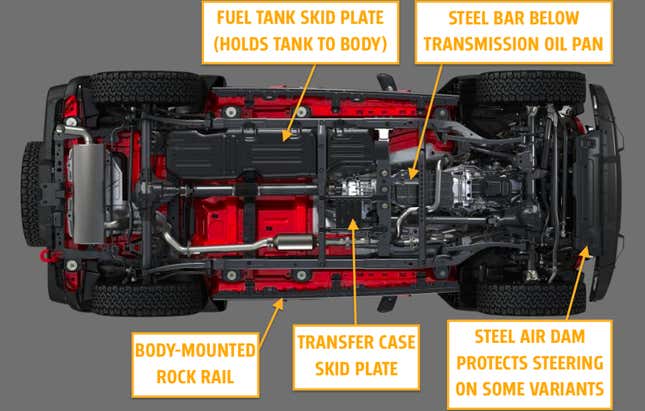
Even with lots of ground clearance and small overhangs, it’s important to protect critical underbody components, and the body itself. We know the JL Wrangler’s underbody is quite well protected, with ribbed steel skid plates over its 17.5 gallons (21.5 for the four-door) fuel tank and transfer case, as well as a little bar under the transmission oil pan, an optional steel steering skidplate, and body-mounted rock rails.
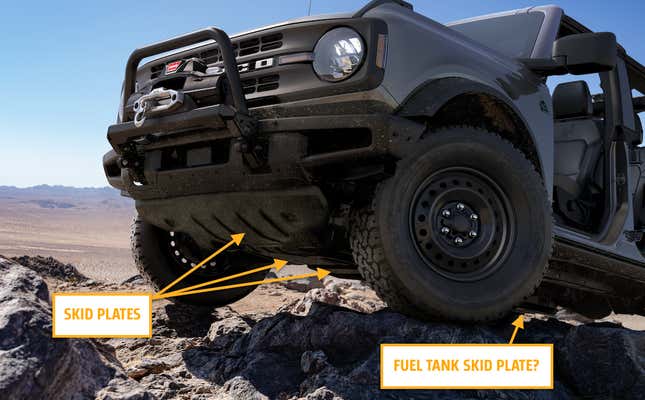
The Bronco’s underbody (I don’t have a great photo of it, sadly), is similarly protected. There’s a steel bash plate up front going from the bumper to the “number one crossmember” (as Groves called it in our interview) on the frame. There’s another skid plate under the engine spanning from the number one to the number two crossmember. There’s apparently a sway bar disconnect shield after the number two crossmember, a transfer case shield, a fuel tank skid plate (which also acts to hold the 16.9 gallon—20.8 for the four-door—tank to the frame. This is a similar scheme to the Wrangler), and small shields for the lower eyes of the rear dampers. Plus, there are body-mounted rock rails.
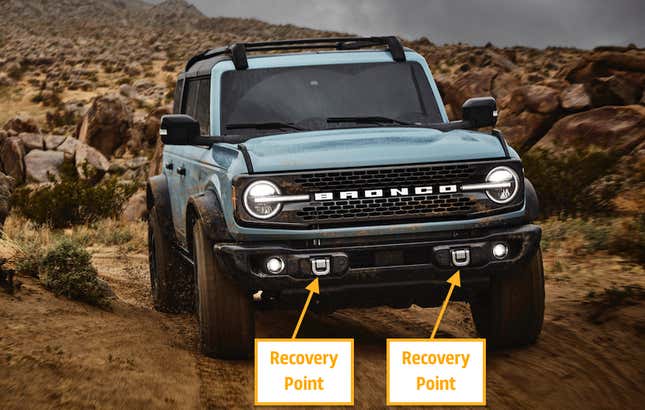
I’ll have to take a close look before passing judgment, but based on what engineers told me, the Bronco’s belly seems well protected. Rock rails should keep rocks from dinging the body, and detachable plastic fender flares should take the brunt of off-roading in dense forests and tight rock gardens.
As for recovery points, those shackles shown above on the front bumpers look beefy, and I bet the loops on the rear of the frame are, too:

The Wrangler also has a hitch on the rear, and a singular, driver-side hook instead of a loop on either side like on the Bronco:

Upfront, the Wrangler’s recovery points aren’t shackles, but rather hooks, which look like fangs above the front bumper:

I like the Jeep’s hooks since they allow you to just throw a tow strap loop around them quickly, though, intuitively, I’d think the Bronco’s fully-enclosed recovery points are a bit stronger (but of course, it’s hard to know for sure without testing them).
So, What’s The Takeaway?
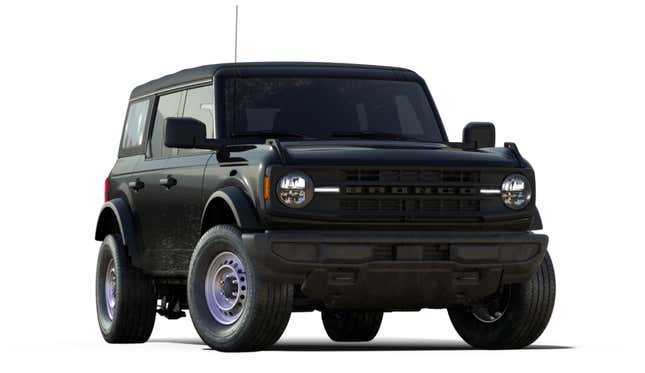
There’s still so much more we could talk about. We could mention that the Bronco is rated to ford 33.5 inches of water, while the Wrangler is rated at 30 inches at 5 mph. We could talk about interior floorboard drain holes to let out water (both vehicles have them), we could mention towing (all Broncos are rated at 3,500 pounds—the same as the four-door Wrangler. Two-door JL’s are rated at 2,000 pounds).
We could also mention the tires (Rubicon gets BF Goodrich KO2s and Falken Wildpeak M/Ts, while the Bronco gets Goodyear Territory M/Ts if you opt for the 35s or one of the 33-inch options, while the KO2 is also available as a 33).
This article could continue into infinity because there’s a lot to compare, but in the end, it’s clear that the Bronco came to win. With optional 35-inch tires, its off-road geometry (other than overall size) is favorable when compared with the JL Wrangler’s. The Ford’s short overhangs and tremendous ground clearance on the most off-road-oriented models give it some serious chops to go toe-to-toe with the Wrangler. It’s got the right underbody protection, it’s got the right recovery points, it’s got the right gearing—everything it needs to compete with the Jeep on a variety of off-road surfaces is there.
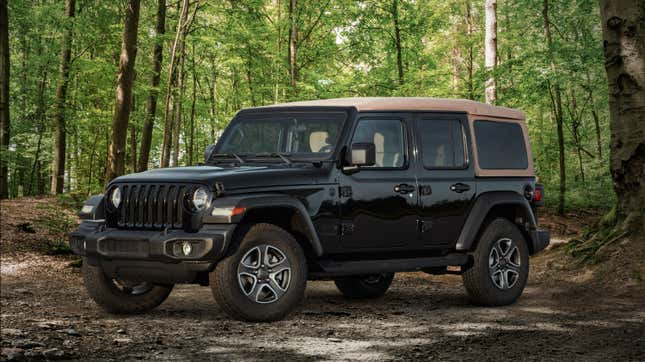
Will it flex as well as the Jeep? No. Will it be as easily lifted? No. Will it be as durable off-road? Who knows. There’s a good chance that, as an off-road platform meant to act as a starting point for modifications, the solid-front-axle-Wrangler will be the better choice (especially for rock crawling). But out of the box and on a variety of off-road terrains, I think the Sasquatch-package Bronco has what it takes to outshine the Jeep Wrangler Rubicon—the undefeated champion of the hard-core off-road segment. Without the Sasquatch package and in more basic trims, though (see the vehicles in the two photos above)? I think the Jeep’s geometry will give it the advantage.
I can’t wait to find out.
